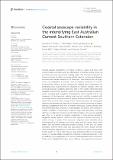Files in this item
Coastal seascape variability in the intensifying East Australian Current Southern Extension
Item metadata
| dc.contributor.author | Phillips, Lachlan R. | |
| dc.contributor.author | Malan, Neil | |
| dc.contributor.author | Roughan, Moninya | |
| dc.contributor.author | Harcourt, Robert | |
| dc.contributor.author | Jonsen, Ian | |
| dc.contributor.author | Cox, Martin | |
| dc.contributor.author | Brierley, Andrew S. | |
| dc.contributor.author | Slip, David | |
| dc.contributor.author | Wilkins, Adam | |
| dc.contributor.author | Carroll, Gemma | |
| dc.date.accessioned | 2022-10-13T11:30:03Z | |
| dc.date.available | 2022-10-13T11:30:03Z | |
| dc.date.issued | 2022-09-21 | |
| dc.identifier | 281699738 | |
| dc.identifier | f9bfa123-dc13-4623-9133-5154b7ff95f8 | |
| dc.identifier | 000864734800001 | |
| dc.identifier | 85140607595 | |
| dc.identifier.citation | Phillips , L R , Malan , N , Roughan , M , Harcourt , R , Jonsen , I , Cox , M , Brierley , A S , Slip , D , Wilkins , A & Carroll , G 2022 , ' Coastal seascape variability in the intensifying East Australian Current Southern Extension ' , Frontiers in Marine Science , vol. 9 , 925123 . https://doi.org/10.3389/fmars.2022.925123 | en |
| dc.identifier.issn | 2296-7745 | |
| dc.identifier.other | Jisc: 641108 | |
| dc.identifier.other | ORCID: /0000-0002-6438-6892/work/120849878 | |
| dc.identifier.uri | https://hdl.handle.net/10023/26190 | |
| dc.description | Funding information: This study was funded by Australian Research Council Linkage Grants (LP110200603 awarded to RH, DS and Iain Field, and LP160100162 awarded to IJ, Martina Doublin, MC, GC, DS, Iain Suthers and RH) with contributions from the Taronga Conservation Society Australia, NSW National Parks and the Australian Antarctic Division. | en |
| dc.description.abstract | Coastal pelagic ecosystems are highly variable in space and time, with environmental conditions and the distribution of biomass being driven by complex processes operating at multiple scales. The emergent properties of these processes and their interactive effects result in complex and dynamic environmental mosaics referred to as “seascapes”. Mechanisms that link large-scale oceanographic processes and ecological variability in coastal environments remain poorly understood, despite their importance for predicting how ecosystems will respond to climate change. Here we assessed seascape variability along the path of the rapidly intensifying East Australian Current (EAC) Southern Extension in southeast Australia, a hotspot of ocean warming and ecosystem tropicalisation. Using satellite and in situ measures of temperature, salinity and current velocity coupled with contemporaneous measurements of pelagic biomass distribution from nine boat-based active acoustic surveys in five consecutive years, we investigated relationships between the physical environment and the distribution of pelagic biomass (zooplankton and fish) at multiple timescales. Survey periods were characterised by high variability in oceanographic conditions, with variation in coastal conditions influenced by meso-to-large scale processes occurring offshore, including the position and strength of eddies. Intra-annual variability was often of a similar or greater magnitude to inter-annual variability, suggesting highly dynamic conditions with important variation occurring at scales of days to weeks. Two seascape categories were identified being characterised by (A) warmer, less saline water and (B) cooler, more saline water, with the former indicating greater influence of the EAC on coastal processes. Warmer waters were also associated with fewer, deeper and less dense biological aggregations. As the EAC continues to warm and penetrate further south, it is likely that this will have substantial effects on biological activity in coastal pelagic ecosystems, including a potential reduction in the accessibility of prey aggregations to surface-feeding predators and to fisheries. These results highlight the import role of offshore oceanographic processes in driving coastal seascape variability and biological activity in a region undergoing rapid oceanic warming and ecological change. | |
| dc.format.extent | 17 | |
| dc.format.extent | 10503882 | |
| dc.language.iso | eng | |
| dc.relation.ispartof | Frontiers in Marine Science | en |
| dc.subject | Marine Science | en |
| dc.subject | Seascape | en |
| dc.subject | East Australian Current Extension | en |
| dc.subject | Climate change | en |
| dc.subject | Coastal processes | en |
| dc.subject | Marine ecosystems | en |
| dc.subject | Spatiotemporal variability | en |
| dc.subject | Active acoustics | en |
| dc.subject | GC Oceanography | en |
| dc.subject | QE Geology | en |
| dc.subject | DAS | en |
| dc.subject | SDG 13 - Climate Action | en |
| dc.subject | SDG 14 - Life Below Water | en |
| dc.subject | MCC | en |
| dc.subject.lcc | GC | en |
| dc.subject.lcc | QE | en |
| dc.title | Coastal seascape variability in the intensifying East Australian Current Southern Extension | en |
| dc.type | Journal article | en |
| dc.contributor.institution | University of St Andrews. Arctic Research Centre | en |
| dc.contributor.institution | University of St Andrews. School of Biology | en |
| dc.contributor.institution | University of St Andrews. Scottish Oceans Institute | en |
| dc.contributor.institution | University of St Andrews. Centre for Research into Ecological & Environmental Modelling | en |
| dc.contributor.institution | University of St Andrews. Pelagic Ecology Research Group | en |
| dc.contributor.institution | University of St Andrews. Marine Alliance for Science & Technology Scotland | en |
| dc.identifier.doi | https://doi.org/10.3389/fmars.2022.925123 | |
| dc.description.status | Peer reviewed | en |
This item appears in the following Collection(s)
Items in the St Andrews Research Repository are protected by copyright, with all rights reserved, unless otherwise indicated.

